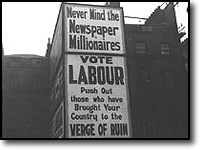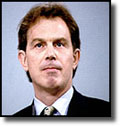
|
The Labour Party
John Smith House Walworth Road London SE17 1JT Tel 0171 701 1234 Fax 0171 277 3300 Email - labour-party@geo2.poptel.org.uk www.labour.org.uk Full text of the Labour manifesto Basic Principles
The Labour Party grew out of a coalition of socialists, Marxists, social democrats, trade unionists and others. Some socialists like Tony Benn have traced the origins of the party as far back as the 'levellers' of the seventeenth century. Each strand of the party has brought its own ideological baggage or pragmatism to the party. These strands have also seen their influence wane over the years and there have, of course, been changes in the party's beliefs. However, basic beliefs in 'progressive' politics, social justice, internationalism and 'democratic socialism' have remained constant - whereas much more debate has centred on the means by which these objectives can be achieved. Formally, the Labour party's annual conference is its supreme authority. The party is in effect 'under the direction and control of the party conference'. The conference agrees on party policy and also elects the National Executive Committee (NEC) which, 'takes the political and management decisions for the party outside Annual Conference.' The influence or power of the Party Conference in relation to the parliamentary leadership has varied over the years. History
By 1922 Labour became the official opposition for the first time. The first Labour government (a minority administration) took office in 1924 and lasted just 11 months. In 1929 Labour formed a second minority government which fared little better than the first, collapsing in 1931 when party leader, Ramsay McDonald, formed a National government with the Conservatives and Liberals. What remained of the party was now led by Arthur Henderson. It was not until the second world war (1939-1945) that the Labour Party was to enjoy a sustained period in Government. When the Conservative leader, Winston Churchill, formed a national government in May 1940, the then Labour leader, Clement Attlee and his colleagues Ernest Bevin and Herbert Morrison were all given Cabinet positions. In the general election of July 1945, Labour were returned with a majority for the first time, to the surprise of most commentators and Attlee himself. Attlee's post-war government created an impressive record of social and economic reform during its six years in office. The National Health Service was established, coal, iron, steel and the railways were all nationalised and the British colonies of India and Burma were granted independence. The Party was not returned to office again until the 1960's. Harold Wilson succeeded Hugh Gaitskell as leader in 1963 after Gaitskell's unexpected and untimely death. In 1964 Wilson ended what he termed the 'thirteen wasted years' of Tory rule. But Labour struggled to manage the economy and were forced to devalue the pound in 1967. Wilson lost the general election of 1970 to the Conservatives under Edward Heath. Wilson returned to office in 1974 after Heath proved unable to halt the industrial strife that was undermining the British economy. Two years later Wilson shocked the nation when he resigned as Prime Minister and leader of the Labour Party, to make way for a successor in time for the next general election. Jim Callaghan, the Foreign Secretary, became party leader and Prime Minister. The industrial unrest that had undermined Heath and the Conservatives in 1974 returned to unseat the Labour government in the general election of 1979. During the winter of 1978-1979 (later dubbed 'the winter of discontent') widespread strikes crippled the economy, the resurgent Conservatives succeeded in pinning the blame firmly on Labour's shoulders helped by a highly effective series of election posters designed by the advertising agency Saatchi and Saatchi. The slogan 'Labour isn't working' struck a cord with the voters and the Conservatives were returned to power under the leadership of Britain's first woman Prime Minister, Margaret Thatcher. Labour responded to defeat by lurching to the left. A new leader, Michael Foot, was elected and radical new policies were proposed. In 1981 the Wembley conference increased the influence of trade unions on the party conference itself in the selection of Labour parliamentary candidates. This triumph of the left prompted leading figures on the party's right to quit. Shirley Williams, Roy Jenkins, Bill Rodgers and David Owen set up the Council for Social Democracy, initially a pressure group inside the party which eventually led to the creation of a new political party of the centre right, the Social Democratic Party (SDP). Labour went into the 1983 general election proposing withdrawal from the Common Market and the abandonment of Britain's independent nuclear deterrent. The election resulted in a Tory landslide. Labour polled 27.6% of the vote, a post-war low, while the SDP/Liberal Alliance took 25.4%. A long slow process of rebuilding was now to take place. Foot was replaced by Neil Kinnock who went on to tackle the hard-left Militant Tendency, a Trotskyist splinter group that had infiltrated the party, in time for the 1987 election. 1987 saw a slick Labour campaign fail to make an impression on Mrs Thatcher's majority, leaving the Tories to govern for a third term. Kinnock stayed on as party leader and succeeded in removing the electoral handicaps of unilateral disarmament and renationalisation in a bid to make Labour more popular with the voters. In the 1990s In 1990, John Major took over from Margaret Thatcher as leader of the Conservative Party and Prime Minister. The change of Tory leadership wrong footed Labour but nevertheless the party, under the leadership of Neil Kinnock, went into the 1992 election preparing for victory. By contrast Major's unpopular government was struggling to deal with the problems created by a severe recession. In the event Labour lost its fourth election in succession. Kinnock was replaced as leader shortly after the election by John Smith with Margaret Beckett as the new deputy leader. Smith was determined to press on with Kinnock's policy of modernising the party. In 1993 he succeeded in introducing One Member One Vote (OMOV) thus reducing the influence of the unions on both the party conference and the selection of parliamentary candidates.
As Labour moved into the election campaign Blair gained the support of the party for his modernisation policies. Under the 'Road to the Manifesto' process, party members were balloted on party policy, leading Blair to proclaim that "For the first time a political party will be entering a general election with its programme for Government voted on by its members." This policy review resulted in five key policy pledges including reducing class sizes, fast track punishment for young offenders, cutting of NHS waiting lists, getting 250,000 unemployed 16-25 year olds off benefit and into work and a pledge to maintain low inflation. Blair's modernisation of the party and the move away from traditional Labour values caused some disquiet. The re-writing of clause IV prompted the departure of some left-wingers to form the Socialist Labour Party on 1 May 1996. Labour's reliance on spin doctors and the strict party discipline imposed by Blair also caused some murmurs of discontent, particularly from Clare Short, the then Shadow Minister for Overseas Development. Labour ran into problems over the policy of all-women shortlists for parliamentary candidates, which had to be dropped after a tribunal declared the policy sexist. As well as policies laid out in the 'Road to the Manifesto' process, Labour has been working hard in recent years to shed its tax and spend image. As Shadow Chancellor, Gordon Brown pledged that if elected, he would not increase income tax for the life of a Parliament. Blair is committed to low inflation and intends to leave many of the Conservatives' market reforms in place. The party also tried hard to become the party of law and order in the mind of the public. Blair's famous pledge to be "tough on crime and tough on the causes of crime" was reinforced by Jack Straw: the then Shadow Home Secretary promoted a tough stance on juvenile crime and advocated curfews for 10-year-olds. The Campaign Labour approached the general election in good shape. The consistently positive poll ratings and an impressive by-election victory in Wirral South augured well for Labour's general election performance. Even so, the spectre of 1992's defeat prevented even the most optimistic Labour forecasters from daring to predict anything like the landslide or record-breaking outcome that they ultimately secured. At the polls, challenges from Independent and "New Labour" candidates and from other left wing parties, such as Socialist Labour (which all won 0.2% votes or less), had minimal impact on Labour's 44.4% lion's share of the vote. Labour won 419 seats in total (including the Speaker's seat), up 146 on the previous Parliament. Their majority was a formidable 179. The landslide represented a swing of 10.3% from the Conservative to Labour. 183 of the 260 brand new intake are Labour MPs. New Labour, New Government Interesting winners included Gisela Stuart, who won the first marginal seat of the night: Birmingham Edgbaston, which had not been a Labour seat since 1922. Two of Neil Kinnock's 1992 campaign team - Charles Clarke and Patricia Hewitt - both won seats. Along with a brood of Blairite twenty-somethings, the younger, more female-populated Commons also welcomes two ex-presidents of the National Union of Students, Lorna Fitzsimons and Jim Murphy. The election resulted in a record 120 women in Parliament, 102 of whom will sit on the Government benches. Blair has also selected an unprecedented total of five women for his first Cabinet - Clare Short, Margaret Beckett, Harriet Harman, Mo Mowlam and Ann Taylor. Labour Party Home PageExternal links are not endorsed by the BBC |
Diana, Princess of Wales, 1961-1997
Conference 97
Devolution
The Archive
News |
Issues |
Background |
Parties |
Analysis |
TV/Radio/Web
Interactive |
Forum |
Live |
About This Site
News |
Issues |
Background |
Parties |
Analysis |
TV/Radio/Web
Interactive |
Forum |
Live |
About This Site
© BBC 1997 |
politics97@bbc.co.uk |


